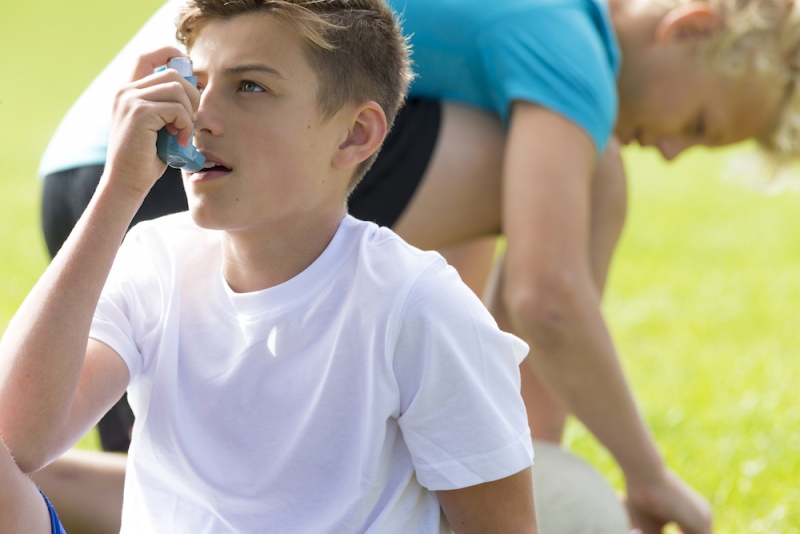Table of Contents Show
Feeling out of breath when doing sports is quite common. But, extreme shortness of breath or wheezing can be a sign of exercise-induced asthma. Learn more about this condition, its symptoms, and how to treat it.
When we exercise, we put our bodies to the test, and many times we take it to the extreme. Tiredness and shortness of breath are common after continued exertion. These signs can indicate that we are doing a good physical job or alert us to something serious.
In this case, we speak of exercise-induced asthma (EIB) in which there may be bronchospasm (narrowing of the bronchus). It is a respiratory condition caused by intense physical activity.
What are the symptoms of exercise-induced bronchoconstriction?
If you have EIB, you may experience one or a combination of four symptoms: shortness of breath, a dry, non-productive cough, chest tightness, or wheezing (a whistling sound when you breathe).
Some of these symptoms (for example, trouble catching your breath) can easily be mistaken for the effects of pushing yourself too hard or being a little out of shape. So how can you tell if it’s EIB?
In general, the symptoms of exercise-induced bronchoconstriction are quite precise as far as time is concerned. ” They tend to appear within the first 6 to 8 minutes of exercise, and last 10 minutes after training,” says Wang. That’s because exercise initially expands the airways. But, as you keep moving with the EIB or when you stop, the airways may constrict more than usual.
” If you have EIB, the symptoms go away, usually within 30 to 60 minutes,” he adds. “That’s different from the short-term effort, it’s like you’re pushing hard in a sprint .” “In that case, you’d catch your breath a lot quicker than that,” says Wang.
If symptoms persist after that period of time, or if they worsen, especially if you have a history of or asthma and have used a quick-relief inhaler, they may indicate an asthma attack. “In that case, you should seek medical attention immediately, as you may be life-threatening if you don’t treat it,” Wang says.
Still, any shortness of breath or chest tightness during a run requires medical attention. “EIB symptoms are also associated with other conditions such as heart attack, congestive heart failure, arrhythmias, and congenital heart defects,” Wang says. Make an appointment with your doctor.
What exercise-induced for asthma?
Exercise-induced asthma (EIB) is a narrowing or constriction of the airways – the bronchi and bronchioles – that are in the lungs. This type of asthma causes shortness of breath, wheezing, coughing, and other symptoms during or after exercise.
This condition, also known as exercise-induced bronchoconstriction, commonly affects those with chronic asthma. But, it can also be suffered by people in good physical condition.
EIB usually occurs within 2 to 5 minutes after exercise, peaks after 10 minutes, and resolves in about 60 minutes. A study published in the journal Nature found that most sufferers can exercise and stay active with asthma medications and preventive measures.
What are the causes of exercise-induced asthma?
Although the causes are not clear, people with chronic asthma and allergies are at higher risk for EIB. In fact, around 90% of people with asthma suffer from exercise-induced bronchoconstriction, a condition also very common in elite athletes.
High-intensity activities and those that involve deep breathing for prolonged periods, such as long-distance running, swimming, or playing soccer, can induce bronchospasm. Also, these factors can act as triggers or increase the risk of suffering them.
- Cold, dry air (can irritate airways and constrict muscles)
- Air pollution
- Irritating substances (such as chlorine)
- Chemicals for ice cleaning equipment
Symptoms of exercise-induced asthma
The symptoms of exercise-induced asthma usually begin after physical exertion and can last for an hour or more. These are usually the most common symptoms:
- Cough, wheezing, shortness of breath
- Chest pain or tightness (more severe than exercise, can affect ribs and back)
- Dizziness (occurs when the airways are so blocked that they don’t get enough oxygen)
- fatigue when exercising
- Avoiding activities (this is a common sign in young children)
Treatment for exercise-induced asthma
Exercise-induced asthma is a manageable condition, which does not prevent sufferers from leading a normal life and exercising. These are the usual treatments:
- Inhalers. Fast-acting, they are used before exercise. They usually include albuterol and levalbuterol, substances that relax the muscles around the airways.
- To control long-term chronic asthma, doctors may prescribe oral anti-inflammatories or inhaled steroids.
Ways to avoid exercise-induced asthma
In addition to medical guidelines, symptoms of bronchoconstriction can be prevented or minimized by following certain guidelines.
- Extend the heating. If you spent 5 minutes before, expand to 10 before you start exercising.
- Breathe through the nose to warm up. Thus, the air is humidified before it enters the lungs.
- Wear a face mask. It is practical when exercising, especially in the coldest months of the year.
- Avoid pollen. If you have allergies, don’t exercise outside when there is a high pollen load in the air.
- Avoid roads and spaces with high levels of pollution.
As you can see, exercise-induced asthma is a common respiratory condition, which can be treated in a simple way (but with medical advice) to maintain the sports routine.

